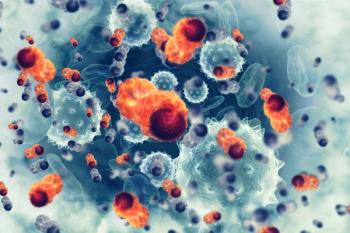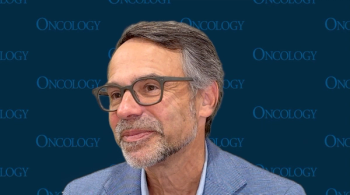
- ONCOLOGY Vol 14 No 11
- Volume 14
- Issue 11
Phase II Study of Thalidomide as an Antiangiogenic Agent in the Treatment of Recurrent Glioblastoma Multiforme
Thalidomide (Thalomid) has been demonstrated to be an antiangiogenic agent with some activity in glioblastoma multiforme. This ongoing study currently has 37 enrolled patients. Patients were started on a dose of 100 mg/d of thalidomide. This was increased by 100 mg/d, weekly, to a maximum dose of 500 mg/d, if tolerated. The mean age was 52 years (range: 27–69 years). The male/female ratio was 19/18. The mean dose tolerated was 300 mg, with a range of 200 to 500 mg/d.
Thalidomide (Thalomid) has been demonstrated to be an antiangiogenic agent with some activity in glioblastoma multiforme. This ongoing study currently has 37 enrolled patients. Patients were started on a dose of 100 mg/d of thalidomide. This was increased by 100 mg/d, weekly, to a maximum dose of 500 mg/d, if tolerated. The mean age was 52 years (range: 2769 years). The male/female ratio was 19/18. The mean dose tolerated was 300 mg, with a range of 200 to 500 mg/d.
Patients were stratified by such prognostic factors as debulking surgery, previous response to treatment, age, and performance status. Twenty-seven patients had documented glioblastoma multiforme at initial diagnosis, while 10 were initially diagnosed as having lower grade tumors and were confirmed to have glioblastoma multiforme at recurrence. At initial diagnosis, 28 patients had debulking surgery. All patients had received radiotherapy. Seventeen patients had received prior chemotherapy.
Thirty-four patients were assessable for response: 5 (15%) patients achieved a partial response and 11 (32%) achieved stable disease. Eighteen patients had progressive disease. The median survival in this group was 27 weeks. In all the patients in whom a partial response or stable disease was achieved, there was either a stabilization or reduction in the steroid dose. Assessment of quality of life or Karnofsky performance status also showed improvement or stabilization in the group of patients with partial response or stable disease. Plasma vascular endothelial growth factor (VEGF) levels were assessed in these patients. There was no correlation with plasma VEGF levels and response or prognosis. Thalidomide was well-tolerated with no grade 4 toxicities. The most common toxicity was fatigue. Skin rash occurred in four patients. Quantitative sensory neural testing was performed on all patients, three of which demonstrated deterioration and two of which had associated paresthesia.
CONCLUSION: Thalidomide is a well-tolerated antiangiogenic agent with some biologic activity in recurrent glioblastoma multiforme.
Articles in this issue
about 25 years ago
Clinical Oncology, Second Editionabout 25 years ago
Early Diet May Play Important Role in Breast Cancer RiskNewsletter
Stay up to date on recent advances in the multidisciplinary approach to cancer.
















































































